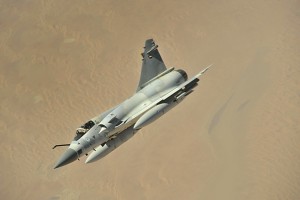New satellite photos of Al Khadim air base taken in December 2016 clearly indicate that the United Arab Emirates is on the verge of deploying fighter jets to Libya, like reported by warisboring.com.
The Emirati planes would back up Libyan general Khalifa Haftar, whose Libyan National Army is one of two major regimes vying for control of the failed state.
To be clear, the UAE air force has been engaged in Libya for months, now. Emirati IOMAX AT-802 Air Tractor attack planes and Chinese-made Wing Loong drones have been flying from Al Khadim since at least July 2016.
Their pilots — most of them are American mercenaries working for Erik Prince —regularly carry out air-support missions on behalf of Libyan National Army fighters battling Islamic militants in Benghazi, on Libya’s northeastern coast.
Construction has been underway at Al Khadim in northeast Libya nonstop since the summer of 2016. In early September 2016, two small shelters appeared on the tarmac. They probably house maintainers working on the Air Tractors and Wing Loongs. Additional shelters popped up on the main tarmac in November and December 2016.
A second large parking area is also under construction in the base’s southeast corner. Shelters have begun appearing on this ramp, too. The latest satellites images, dated Dec. 17 and 30, 2016, clearly show earth-moving vehicles working on this new parking area.
Much of the equipment the Emiratis needed to build up Al Khadim arrived on Il-76 freighters. The LNA keeps one Il-76 in Tobruk. It’s blue and white, whereas the Il-76s visible in satellite imagery of Al Khadim are white.
Haftar’s allies in the Tobruk regime have employed foreign transport companies since 2015. Two of them have Il-76s in their fleet — Sky Prim Air and Oscar Jet. These two companies belong to the same Moldovan family — the Ghilans.
On Dec. 11, 2016, Oscar Jet Il-76TD with the serial ER-IAX transported a delegation from Benina to Brak Al Shati. Two days later, another Il-76 from Sky Prim Air landed by night at the same air base with a load of cargo.
It’s reasonable to assume these same aircraft maintain the air bridge to Al Khadim.
All the new shelters at the base could provide the Emiratis a lot of cover if and when they deploy more aircraft to Libya. Additional deployments — of fighter jets, specifically — are likely, as the current UAE contingent is reaching the limits of its combat capacity.
The current Air Tractors and UAVs are just barely sufficient for covering LNA operations in Benghazi, especially as the LNA succeeded in seizing the city’s Ganfouda district in late January 2017.
The LNA must also contend with escalating challenges in Libya’s oil crescent, in the center of the country. The propeller-drive Air Tractors flying from Al Khadim lack the speed and range to effectively strike targets in the oil crescent and the western city of Misrata, where many of the major militants are based.
To extend its support of the LNA into western Libya, the UAE will probably have to forward-deploy jet-powered F-16s or Mirage 2000s. The Emirates already have experience with foreign fighter deployments. The UAE air force maintains a base at Assab airport in Eritrea, from where the Emiratis operate Mirage 2000s and Wing Loongs.
The Mirage 2000s would be very effective in Libya. With the Wing Loongs helping to spot targets, the nimble Mirages could drop precision-guided munitions.
The deployment of Mirage 2000s “could eventually also allow an offensive towards Fezzan” in southwestern Libya, said Wolfgang Putszai, Austria’s former defense attaché to Italy, Greece, Tunisia and Libya.
“But there is still doubt that the LNA has the capability to take cities like Misrata,” Putszai continued. Emirati air strikes could effectively bottle up militants in the city. “The Misratan would certainly realize that they can forget any major offensive to take the oil crescent.
“Such a powerful capability would encourage the Misrata even more to seek direct negotiations with the LNA — which would be very positive.”



